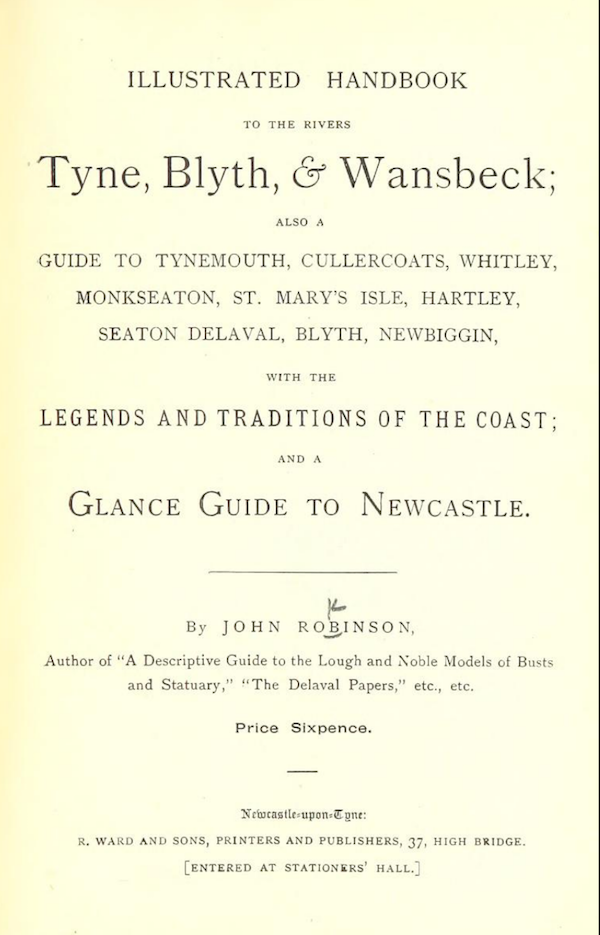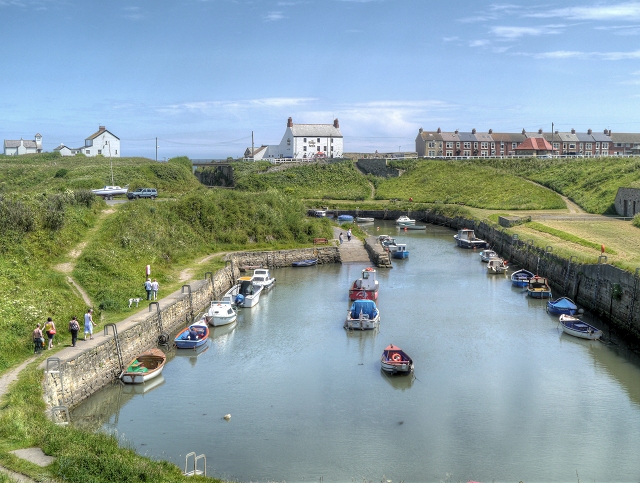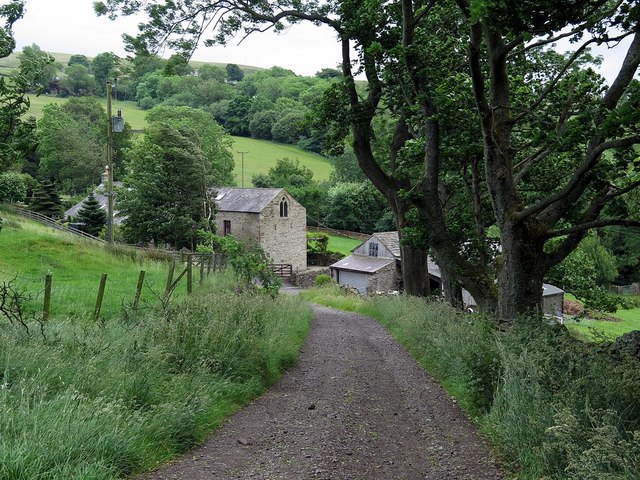Topics > Northumberland > Seaton Sluice > Historical Account of Seaton Sluice, 1894
Historical Account of Seaton Sluice, 1894
Extract from: JOHN ROBINSON (1894), ILLUSTRATED HANDBOOK TO THE RIVERS Tyne ,Blyth,& Wansbeck; ALSO A GUIDE TO TYNEMOUTH, CULLERCOATS, WHITLEY, MONKSEATON, ST. MARY'S ISLE, HARTLEY, SEATON DELAVAL, BLYTH, NEWBIGGIN, WITH THE LEGENDS AND TRADITIONS OF THE COAST; AND A Glance Guide to Newcastle.
SEATON SLUICE.
THE glory of the ancient harbour of Seaton Sluice, or Hartley Pans, is its past history. From time immemorial salt had been manufactured at Hartley Pans; and then followed the development of the coal trade; which, in the time of Charles IL, had grown to such importance that its exportation from the port necessitated greater facilities for transit. It was then that Sir Ralph Delaval improved the harbour by erecting a Sluice at the point where the old bridge now stands; and where even now part of the machinery for working the Sluice gates are yet to be seen. The process of cleaning the harbour from the usual deposit of sand, was simple, yet efficacious; at high tide the Sluice gates were closed, which dammed back the water which came down the Hartley Burn; at low tide, when the harbour was almost dry, the Sluice gates were opened, when the pent up waters rushed through the harbour to the sea, and cleaned the basin of the harbour of every particle of sand. The old entrance to the harbour, to the north-east, had a strong stone pier on the north side of the river, which protected the harbour from the strong and stormy seas from the north. The construction of this pier was looked upon in the 17th century as a great engineering achievement. The cranes and other appliances to lift out, or put into position the "booms”, or flood gates of the harbour are yet in position and are worthy of inspection.
For these achievements of private skill and enterprise, Sir Ralph Delaval was created collector, and surveyor of his own port, by special license from King Charles II. The further development of trade to the port during the 18th century, required greater facilities of transit and shipping accommodation; for besides the salt and coal trade, there were now added the copperas and glass trade to the village. "The Royal Hartley Bottle Works" were the most extensive in the kingdom; and during the last half of the 18th century, this now quiet and deserted harbour and village, was the most prosperous and industrious place in the United Kingdom.
The dues and taxes paid on salt, glass, coal, bricks, &c, to Government, in 1785, amounted to upwards of £24,000 for one year alone. It was this increased trade of the port that led Mr. Thomas Delaval to carry out the making of a new entrance to the harbour, through the solid rock ;which was considered the greatest engineering event of that period. It is 900 feet long,30 feet broad, and 52 feet deep from the top of the rock ;opening out the harbour in a straight line with the sea. It was effectually protected from the action of storms by a massive and iron bound stone pier, with heavy flood gates ; so that in the heaviest storms the ships in the harbour were as safe as on a mill pond. From twelve to fifteen ships were often being loaded or waiting for their turn in the quiet harbour. Now all is changed. Desolation sits upon its walls, trade has departed, and its once busy market place is now deserted; its large brew house is turned into the neat Church of St. Paul's; the factory bell, that was wont to call the inhabitants to work now calls them to the house of prayer. The "Square " is a picturesque spot in the village, and ought to be seen; you enter the marketplace behind the Church of St Paul's, and pass under the archway below the old estate and bottle works offices, where a large black stone crest of the Delavals is built into the wall — a Ram's Head - the office is now used as a Sunday School in connection with St. Paul's Church ;class rooms, and recreation rooms are connected with it, which are admirably attended to by the Lady Deaconesses of the Parish. Once inside the Square the old 16th century houses are most picturesque; while the stone steps which lead up to what had been the old granary, are made memorable from the visit John Wesley made to the Hartley Village, and preached to the people from these steps. It was was in the "old Granary" where the most valuable of the "Delaval Papers " were discovered in 1888. Close at hand is the Parochial Hall, once the work rooms of the Bottle Works; while all around are the empty cones of the once famous "Royal Northumberland Bottle Works." From the extensive ruin that is to be seen around, some idea can be formed of the magnitude and the industry of the village when prosperity was at its flood-tide. There are few villages in the United Kingdom which can boast of such a bead-roll of famous descendants as can this quiet, deserted village of Hartley Pans. Merchant princes, Statesmen, Divines, and Painters, have all sprung from families whose names were as familiar as household words in the village in its balmy days. It may interest visitors to this quiet nook, that the Hon. John Morley, M.P., the illustrious essayist, and present prominent statesman and politician, is a descendant of a Hartley family; John Martin, the great artist, spent his boyhood here; and the popular genial Member of Parliament for Morpeth, Mr. Thomas Burt, M.P. for Morpeth, began his public career in the village; while the popular M.P. for Tynemouth, Mr.R.S. Donkin, is associated with its old family residents. Innumerable names well-known in the commercial world are associated with the history of the old historic village. Among its natives must not be forgotten the famous Willy Carr, the strong man of the last century, who with an Herculean strength, combined the manners and chivalry of a gentleman. At the age of 30 he weighed 24 stones, and stood 6 feet4 inches high, and could carry half a ton of iron with .ease.
SEATON LODGE
One of the most picturesque houses in the North of England is Seaton Lodge, the ancient residence of the Delavals. It is two hundred years ago since Sir John Delaval, Bart., boasted that it was the finest thatched house in the kingdom. It yet retains the thatched roof and picturesque appearance. It is impossible to estimate the age of this ancient building; yet, if tradition has any value, it must be among the very few Norman dwelling houses that remain in England. The hiding place of King John is still pointed out to visitors, and the whole building is full of those curious corners and recesses which puzzle modern people as to their use. The situation of the house is all that can be desired, sheltered on all sides from the storms of the coast, the views from its windows up the charming dene, the sheet of water flowing in front of its terraced walks; while behind is one of those old fashioned gardens which delight the eye of all lovers of romantic landscape gardening. Up to the year 1729, when Sir John Delaval died, the last of the old branch of the family, and from whom Admiral Delaval, the builder of Delaval Hall, bought the estate, Seaton Lodge had been the seaside residence of the Delaval family. After the development of the coal trade on the estate by Francis Blake Delaval, and the Bottle Works by Thomas Delaval, the lodge became the private residence of the chief agent of the estate; and within its walls were born the founders of three well-known families who have made a leading position in the commercial history of the North of England; the names of Dryden, Lambert, and Jobling being familiar as household words, the last residents associated with its history being the Misses Joblings, who have won for themselves an undying fame for their acts of charity and native patriotism; they also had the unique honour of being the two best swimmers in the North of England, and in summer and winter took their daily dip in the sea, with a swim of half a mile out or along the coast. A foot bridge at one time crossed the burn in front of the lodge to allow the Delavals and their agents to go to their offices without going round by the Sluice Bridge and climbing the steep bank.
Hartley < Robinson, 1894 > Seaton Lodge

from http://access.bl.uk/item/pdf/…
JOHN ROBINSON (1894), ILLUSTRATED HANDBOOK TO THE RIVERS Tyne , Blyth, & Wansbeck etc.
- JOHN ROBINSON (1894), ILLUSTRATED HANDBOOK TO THE RIVERS Tyne ,Blyth,& Wansbeck; ALSO A GUIDE TO TYNEMOUTH, CULLERCOATS, WHITLEY, MONKSEATON, ST. MARY'S ISLE, HARTLEY, SEATON DELAVAL, BLYTH, NEWBIGGIN, WITH THE LEGENDS …
Added by
Simon Cotterill


from http://access.bl.uk/item/pdf/…
JOHN ROBINSON (1894), ILLUSTRATED HANDBOOK TO THE RIVERS Tyne , Blyth, & Wansbeck etc.
- JOHN ROBINSON (1894), ILLUSTRATED HANDBOOK TO THE RIVERS Tyne ,Blyth,& Wansbeck; ALSO A GUIDE TO TYNEMOUTH, CULLERCOATS, WHITLEY, MONKSEATON, ST. MARY'S ISLE, HARTLEY, SEATON DELAVAL, BLYTH, NEWBIGGIN, WITH THE LEGENDS …
Added by
Simon Cotterill









